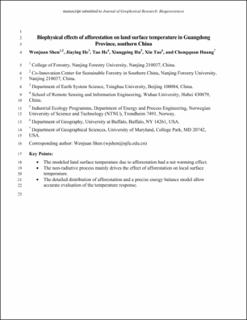| dc.contributor.author | Shen, Wenjuan | |
| dc.contributor.author | He, Jiaying | |
| dc.contributor.author | He, Tao | |
| dc.contributor.author | Hu, Xiangping | |
| dc.contributor.author | Tao, Xin | |
| dc.contributor.author | Huang, Chengquan | |
| dc.date.accessioned | 2022-10-20T07:48:23Z | |
| dc.date.available | 2022-10-20T07:48:23Z | |
| dc.date.created | 2022-08-20T15:59:03Z | |
| dc.date.issued | 2022 | |
| dc.identifier.citation | Journal of Geophysical Research (JGR): Biogeosciences. 2022, 127 (8), . | en_US |
| dc.identifier.issn | 2169-8953 | |
| dc.identifier.uri | https://hdl.handle.net/11250/3027212 | |
| dc.description.abstract | Developing effective climate mitigation strategies under global warming requires a comprehensive understanding of the biophysical mechanism of how afforestation affects the climate and environment. The planted forests in southern China are an essential carbon sink. However, the impacts of radiative and non-radiative processes on land surface temperature caused by converting open land (i.e., grassland and cropland) and natural forests to planted forests remain unclear. We used satellite observations and intrinsic biophysical mechanism theory-based energy balance models to estimate the biophysical impacts of potential afforestation of open land and natural forests on surface temperature from 2000 to 2010 in Guangdong Province, southern China. Results showed that afforestation of open land had a consistent net cooling effect. Due to the afforestation of natural forests, the modeled results revealed that afforestation among all conversion types had a net warming effect of 0.15 ± 0.5 K, which caused by the change in energy redistribution factor although uncertainty remains. While the most significant warming caused by converting natural forest to planted forests was also slightly affected by albedo. The afforestation's non-radiative and radiative processes led to a slight warming of 0.143 ± 0.43 K and a cooling of −0.096 ± 0.19 K, respectively. The non-radiative process dominates the effect of afforestation on the surface temperature, with the overall non-radiative forcing index greater than 73% ± 0.59%. Our study highlights the need of protecting natural forests and provides a practical method for assessing the impacts of afforestation on the local climate and the effectiveness of climate mitigation efforts. | en_US |
| dc.description.abstract | Biophysical Effects of Afforestation on Land Surface Temperature in Guangdong Province, Southern China | en_US |
| dc.language.iso | eng | en_US |
| dc.publisher | Wiley | en_US |
| dc.title | Biophysical Effects of Afforestation on Land Surface Temperature in Guangdong Province, Southern China | en_US |
| dc.title.alternative | Biophysical Effects of Afforestation on Land Surface Temperature in Guangdong Province, Southern China | en_US |
| dc.type | Journal article | en_US |
| dc.type | Peer reviewed | en_US |
| dc.description.version | acceptedVersion | en_US |
| dc.rights.holder | © 2022. American Geophysical Union. All Rights Reserved. | en_US |
| dc.source.pagenumber | 14 | en_US |
| dc.source.volume | 127 | en_US |
| dc.source.journal | Journal of Geophysical Research (JGR): Biogeosciences | en_US |
| dc.source.issue | 8 | en_US |
| dc.identifier.doi | https://doi.org/10.1029/2022JG006913 | |
| dc.identifier.cristin | 2044643 | |
| cristin.ispublished | true | |
| cristin.fulltext | original | |
| cristin.fulltext | postprint | |
| cristin.qualitycode | 2 | |
